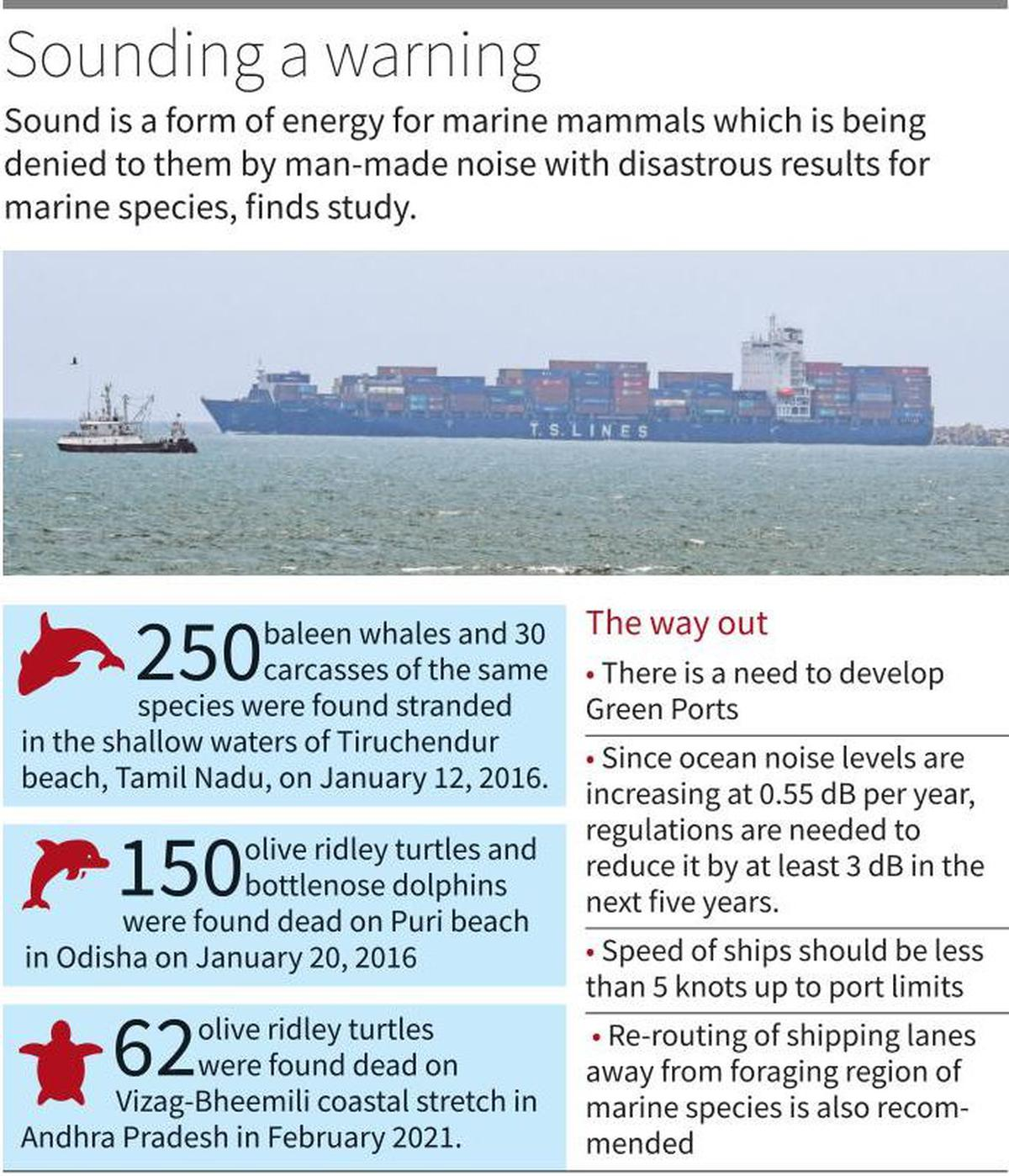Underwater Noise Emissions | 20 Feb 2023
For Prelims: Underwater Noise Emissions, Marine ecosystem, Marine Sound Pollution, Coastal Regulation Zone (CRZ), The London Convention (1972)
For Mains: Marine ecosystem, Marine Sound Pollution and Conservation
Why in News?
According to a News Study, “Measuring Underwater Noise Levels Radiated by Ships in Indian Waters”, the rising Underwater Noise Emissions (UNE) from ships in the Indian waters are posing a threat to the Marine Ecosystem.
- The measurement of the ambient noise levels was carried out by deploying a hydrophone autonomous system around 30 nautical miles from the Goa coastline.
What are the Highlights of the Study?
- Increased UNE Levels:
- The sound pressure levels of UNE in the Indian waters are 102-115 decibels, relative to one microPascal (dB re 1µ Pa).
- Scientists have agreed to use 1µPa as the reference pressure for underwater sound.
- The East Coast level is slightly higher than that of the West. There is an increase by a significant value of about 20 dB re 1µPa.
- The sound pressure levels of UNE in the Indian waters are 102-115 decibels, relative to one microPascal (dB re 1µ Pa).
- Factors:
- Continuous shipping movement is identified to be a major contributor to the increase in the global ocean noise level.
- UNE is posing a threat to the life of mammals like Bottlenose Dolphin, Manatees, Pilot Whale, Seal, and Sperm Whale.
- The main form of energy for multiple behavioural activities of marine mammals, which include mating, communal interaction, feeding, cluster cohesion and foraging, is based on sound.
- Impact:
- The frequencies of ships’ underwater self-noise and machinery vibration levels are overlapping the marine species’ communication frequencies in the low-frequency range of less than 500 Hz.
- This is called masking, which may lead to a change in the migration route of the marine species to the shallow regions and also making it difficult for them to go back to the deeper water.
- The frequencies of ships’ underwater self-noise and machinery vibration levels are overlapping the marine species’ communication frequencies in the low-frequency range of less than 500 Hz.
- However, the sound that radiates from ships on a long-term basis affects them and results in internal injuries, loss of hearing ability, change in behavioural responses, masking, and stress.
What is Marine Sound Pollution?
- Marine sound pollution is the excessive or harmful sound into the ocean environment. It is caused by a variety of human activities, such as shipping, military sonar, oil and gas exploration, and recreational activities like boating and jet skiing.
- It can have a range of negative impacts on marine life, such as its interference with the communication, navigation, and hunting behaviors of marine mammals, such as whales, dolphins, and porpoises. It can also damage the hearing and other physiological functions of these animals, leading to injury or death.
Is there any Initiative to Safeguard Marine Ecosystems?
- Global:
- Global Programme of Action (GPA) for the Protection of the Marine Environment from Land-based Activities:
- The GPA is the only global intergovernmental mechanism directly addressing the connectivity between terrestrial, freshwater, coastal and marine ecosystems.
- MARPOL Convention (1973): It covers pollution of the marine environment by ships from operational or accidental causes.
- It lists various forms of marine pollution caused by oil, noxious liquid substances, harmful substances in packaged form, sewage and garbage from ships, etc.
- The London Convention (1972):
- Its objective is to promote the effective control of all sources of marine pollution and to take all practicable steps to prevent pollution of the sea by dumping of wastes and other matter.
- Global Programme of Action (GPA) for the Protection of the Marine Environment from Land-based Activities:
- Indian:
- Wild Life Protection Act of India (1972): It provides legal protection to many marine animals. There are a total of 31 major Marine Protected Areas in India covering coastal areas that have been notified under Wildlife Protection Act, 1972.
- Coastal Regulation Zone (CRZ): The CRZ notification (1991 and later versions) prohibits developmental activities and disposal of wastes in fragile coastal ecosystems.
- Centre for Marine Living Resources and Ecology (CMLRE): The CMLRE, an attached office of Ministry of Earth Sciences (MoES) is mandated with the management strategies development for marine living resources through ecosystem monitoring and modelling activities.

